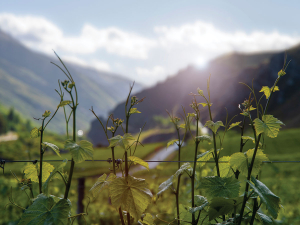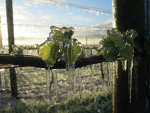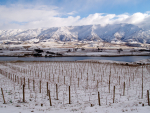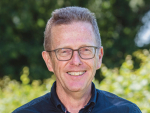The stratospheric warming over Antarctica led to some cold polar air being forced northwards and frosty nights for the growers with early budburst. There has also been an early onset of spring westerlies and this has contributed to mild days along the east coast of both islands and a noticeable increase in wind. Sea surface temperatures remain above average around New Zealand, but the cooling along the western coast of South America and along the equator indicates that another La Niña is on the way. If so, it is likely to arrive by late spring or early summer.
Frost risk under a northwest flow:
Fast moving weather systems are typical of spring, and bring pros and cons when it comes to frost risk. Forecasting frost during unsettled weather patterns can be a challenging task. A strong northwest flow can push wind down to low levels overnight and this helps to keep temperatures mild. Fronts in the flow are usually associated with an increase in cloud and some rain (depending which side of the island you live on) and the chances of frost on these nights are nil. The risk with spring weather is the clearance that often occurs as the wind flow turns southwest and the skies clear. The trick with forecasting frost in these situations is in the timing of the clearance over a region. If a front clears during the afternoon or early evening and a weak ridge of high pressure is present behind the change, there is a chance that conditions will be stable and clear enough for frost risk to increase. If a front clears early in the day it may be that the flow turns northwest during the evening and a milder airmass moves onto a region, so the risk of frost diminishes. However, the frost risk may diminish for some parts of a region but not for others.
A good example to explain this is a developing northwest flow over Marlborough and Hawke’s Bay. Under a developing northwesterly airstream, it is likely that the elevated inland areas such as the upper Wairau Valley (Marlborough) or Crownthorpe/Puketapu (Hawke’s Bay) remain fairly mild as a light northwest breeze pushes down to the surface at times throughout the night. On the plains and towards the coast, the northwesterly airstream is not strong enough to push down to the surface – this can occur in low-lying areas such as Fairhall in Marlborough and the Tukituki River area in Hawke’s Bay. The milder air moving into the region under the northwesterly flow runs across the top of the colder air pooling at the surface, due to warmer air being lighter and less dense than cold air at the surface. It is on these nights that we can see some spectacular ranges in temperature across a single region with frost forming on coastal plains and temperatures barely in single figures on surrounding hillsides.
Outlook for October and November
Gisborne/Hawke's Bay
The mild start to spring is likely to continue for the remainder of the season. There are likely to be periods of mild west to northwest winds, but these may become less frequent during the second half of October and into November. Rainfall totals are likely to run below average during early October, but the frequency and totals could increase during November as more humid northeasterly pattern develops.
Wairarapa
Strong west to northwest winds are felt keenly over the lower North Island, due to the airflow forcing through Cook Strait between the North and South Islands. These winds should start to ease through October and into November, although there may be a few periods where winds do return. Mean temperatures should remain above average and rainfall totals are likely to be close to average as well.
Nelson
The northwest flow can bring higher than normal rainfall to the upper South Island and there is still a chance of moderate to heavy rain events in the Nelson region. As the flow becomes northerly or northeast these rain-bearing fronts should ease. Mean temperatures remain near or above average for the remainder of spring.
Marlborough/North Canterbury
Temperatures remain above average about Marlborough and North Canterbury and there is an increased likelihood of very warm spring days in Canterbury under a northwest flow. The fronts that bring rain to Nelson are also likely to bring rain at times to Marlborough, especially the Wairau Valley. Southern parts of Marlborough,
such as Seddon and Ward, are likely to remain drier, with conditions similar to North Canterbury. The stronger northwesterlies should start to ease by November.
Central Otago
Temperatures are likely to be remain above average. Northwest winds may remain quite strong and frequent through early October, and fronts within the northwest flow may bring above average rainfall to Central Otago. Under this pattern we would expect the heaviest rainfall totals to be recorded in western areas such as Gibbston Valley and Wānaka. The northwest pattern should ease through November and conditions are likely to become more settled with less frequent rain and temperatures remaining fairly mild.
James Morrison runs Weatherstation Frost Forecasting: weatherstation.net.nz














